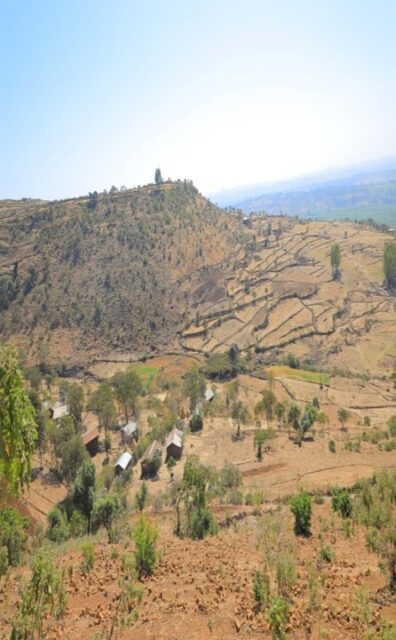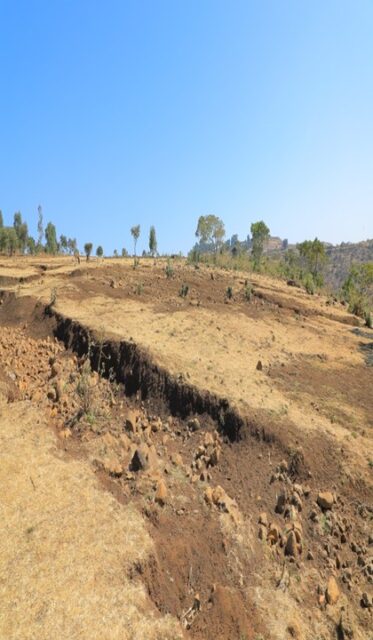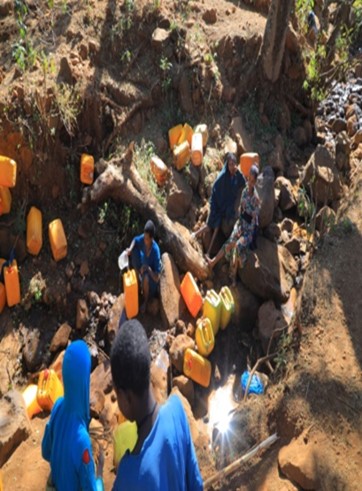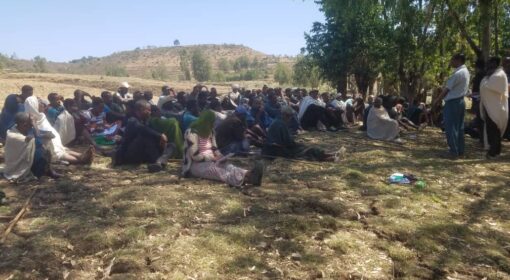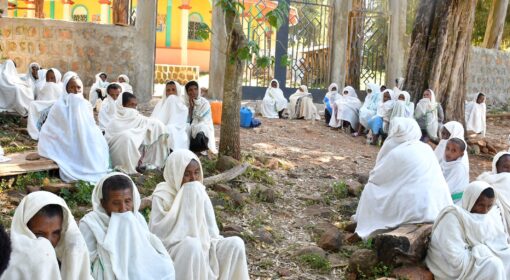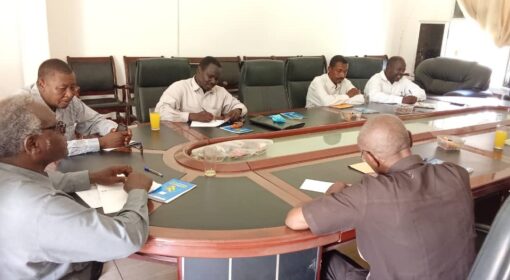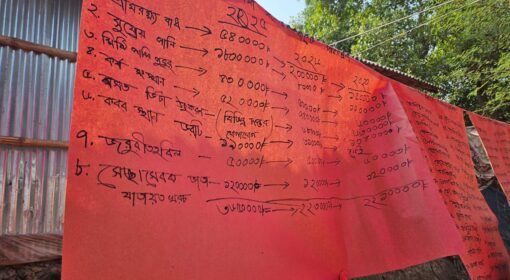by ORDA Ethiopia.
This blog is part of a dossier on locally-led adaptation, featuring insights and lessons from the Reversing the Flow (RtF) program. RtF empowers communities in Bangladesh, Burkina Faso, Ethiopia, Kenya, and Sudan to build climate resilience through direct funding and a community-driven, landscape approach.
Background/Context
Koti Kebele is situated in Yilmana Densa Woreda of the North Gojjam Zone, within the Amhara National Regional State. Located just 17 km from the woreda capital Adet and 35 km from Bahir Dar, the regional capital, Koti encompasses 2,735 hectares and includes six critically degraded watersheds: Dewol-Washaye, Kurfi, Chincho, Adafit, Dawit-Degami, and Gomengie.
This kebele is home to 5,498 people (2,640 males and 2,858 females) including 1,331 households—1,057 male-headed and 274 female-headed.
Problem/Challenge
Although, the watersheds of Koti Kebele—namely Dewol-Washaye, Kurfi, Chincho, Adafit, Dawit-Degami, and Gomengie—have strong potential for agricultural production and livestock management, they face environmental and land use challenges. Key challenges include soil erosion and land degradation, gully formation, deforestation, encroachment on shrub lands, illegal tree cutting, free grazing, shortage of forage and fodder, unreliable rainfall patterns, crop pests and diseases, lack of alternative energy technologies, and unsustainable farming practices.
These challenges have led to significant consequences: loss of forest cover and biodiversity, declining agricultural productivity, reduced livestock yields, the drying up of springs and rivers, and diminished access to drinking water for both people and animals.
| Figure 1. (a) Land degradation & gully formation at Gomengie micro-watershed (b) drinking water shortage Dewol Washaye micro-watershed February, 2025 (images courtesy of ORDA) | ||
Reversing the Flow (RtF) project
Since October 1, 2024, ORDA Ethiopia, in partnership with the Netherlands Enterprise Agency (RVO), has been supporting communities in Koti Kebele to implement the Reversing the Flow (RtF) project. The initiative aims to address landscape degradation, drinking water scarcity, and livelihood challenges exacerbated by climate change.
The RtF project is rooted in a community-led approach, granting local communities full ownership over planning, implementation, and financial management. Community members have taken the lead in routine project activities—mobilizing local resources, purchasing materials at competitive prices, following their local procurement procedures, and transporting materials to project sites. They have also constructed watershed user committee offices and implemented interventions based on their own plans and priorities.
Goal of the project
The RtF’s project goal is to contribute on the livelihood improvement of the people and their environment. It capacitates communities through locally-led adaptation principles and improves their well-being that RtF is founded.
Major strategies/approaches of the project implementation
The project employed a number of community-centered strategies:
- Community Situation Initial Assessment (CSIA): Conducted by the communities themselves to identify needs and resources, with ORDA Ethiopia serving only as a facilitator.
- Integrated Watershed Development Plans: Each of the six watersheds prepared its own plan with technical support from ORDA and local actors.
- Signing of Memoranda of Understanding (MoUs): ORDA Ethiopia signed Memorandum of Understanding with watershed user committees to ensure mutual accountability in re-granting and implementation.
- Development of Working Manuals: Committees, with ORDA’s guidance, created manuals on finance, procurement, internal bylaws, and revolving funds to ensure transparency and proper fund use.
- Capacity Building and Exchange: Training sessions and knowledge-sharing events were held on grant management, procurement, and watershed practices—enhanced by ORDA’s decades of experience, shared through photos, videos, and stories.
- Re-granting Mechanism: Upon signing the MoU, each committee received 30% of their annual budget as an initial grant to start implementation.
- Formation of Watershed User Committees: Community members democratically elected their representatives based on clear criteria. ORDA Ethiopia oversees progress and provides technical backstopping.
Measures implemented
In response to the environmental challenges they faced, such as the shortage of drinking water and youth unemployment, they immediately expressed a desire to address their most pressing problems. Additionally, they envision seeing their villages transformed and becoming greener. The communities have prepared a four-year plan (2025–2028), which is in their hands.
For the first year of implementation, communities initiated integrated landscape development activities to mitigate the impacts. They constructed soil and water conservation structures such as loose stone check-dams, cut-off drains, waterways, hillside terraces, and trenches. These efforts have helped protect significant areas of land from soil erosion. In addition, communities began constructing water supply schemes and offices for watershed user committees to strengthen local coordination and management.
Prior to physical soil and water conservation construction efforts, communities undertook several preparatory and capacity-building activities: (1) conducted an initial community situation assessment; (2) prepared integrated watershed development plans;(3) developed working manuals; (4) signed a Memorandum of Understanding (MoU); and (5) farmer surveyors were trained in the layout, design, and construction of soil and water conservation structures.
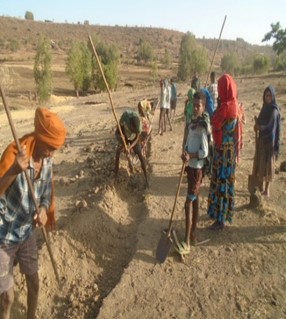
| 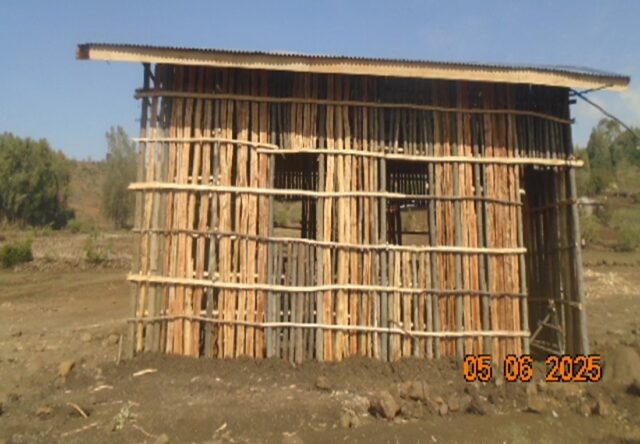 |
| Figure 2. Farm bund and watershed users office construction progress, respectively, at Gomengie micro-watershed, Koti Kebele, March 2025 (images courtesy of ORDA) | |
Outcomes / Results of community-led approaches
Community led approaches has improved the capacity of watershed user committees. The awareness of the community is improved in implementing integrated landscape development activities. Community led approaches are also enabling communities to manage their grant efficiently through the selection of watershed user committees. Communities are rehabilitating their watersheds through the construction of soil and water conservation structures. Sense of ownership of the community to the project progresses and efficient use of funds is enhanced. The hub is only playing a facilitation role rather than guiding them.
Lessons Learned
The RtF project, which adopts community-led approaches, is easily adaptable, widely promoted, and readily accepted by local communities. It effectively utilizes local resources and indigenous knowledge while integrating innovative practices. Communities are being empowered and capacitated through a “learning by doing” approach, driven by their own initiative, interest, planning, and responsibility. Since the project is implemented using the local community’s capacity, local resources, and simple technologies, it can be easily scaled up and replicated in other areas.
With regard to the landscape development plan, while the watershed user committees have prepared a 4 year plan, ORDA Ethiopia, as the coordinating hub, and the watershed user committees have agreed to and signed a Memorandum of Understanding (MoU) only for the first year’s detailed activities. This approach is based on the understanding that shorter-term (yearly) planning allows for greater adaptability to changing local conditions and aligns more realistically with the community’s evolving interests. Also the communities’ perception of their village’s future, they do not typically categorize changes in terms of short- or long-term periods.
Conclusion
The community-led model adopted in the RtF project has empowered the people of Koti Kebele to take control of their development journey. From baseline assessments to purchasing inputs and implementing landscape development activities, the community is actively engaged in every stage of the project cycle.
Through local leadership, enhanced skills, and a strong sense of responsibility, Koti Kebele is becoming a model for integrated watershed management and community resilience in Amhara region.
